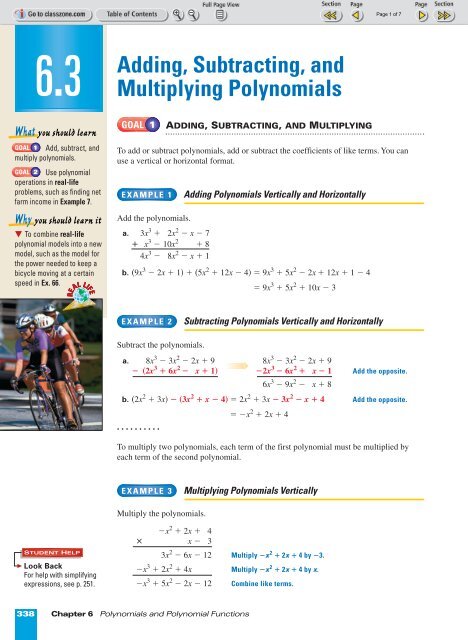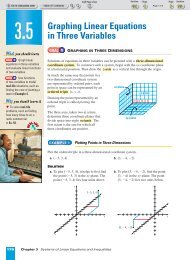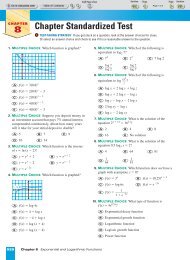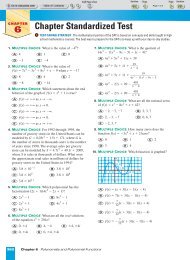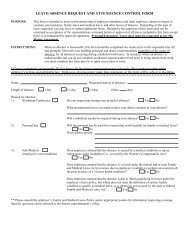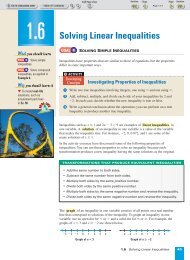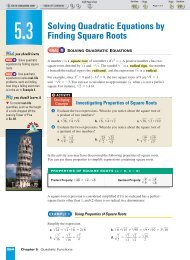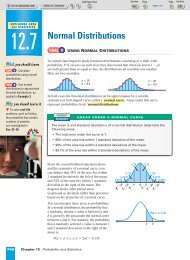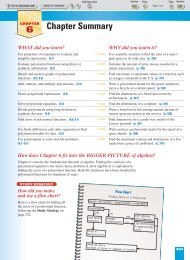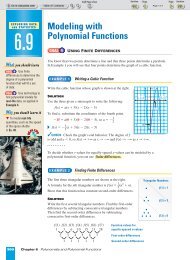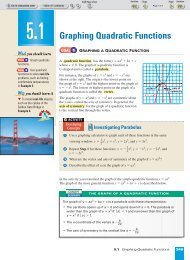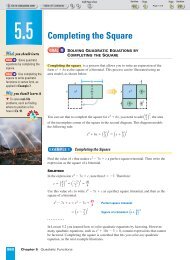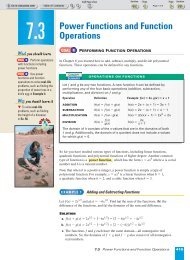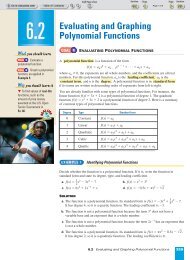Alg. 2 Chapter 6.3 - Beau Chene High School Home Page
Alg. 2 Chapter 6.3 - Beau Chene High School Home Page
Alg. 2 Chapter 6.3 - Beau Chene High School Home Page
You also want an ePaper? Increase the reach of your titles
YUMPU automatically turns print PDFs into web optimized ePapers that Google loves.
<strong>6.3</strong><br />
Adding, Subtracting, and<br />
Multiplying Polynomials<br />
What you should learn<br />
GOAL 1 Add, subtract, and<br />
multiply polynomials.<br />
GOAL 2 Use polynomial<br />
operations in real-life<br />
problems, such as finding net<br />
farm income in Example 7.<br />
Why you should learn it<br />
To combine real-life<br />
polynomial models into a new<br />
model, such as the model for<br />
the power needed to keep a<br />
bicycle moving at a certain<br />
speed in Ex. 66.<br />
REAL<br />
LIFE<br />
GOAL 1<br />
ADDING, SUBTRACTING, AND MULTIPLYING<br />
To add or subtract polynomials, add or subtract the coefficients of like terms. You can<br />
use a vertical or horizontal format.<br />
EXAMPLE 1<br />
Add the polynomials.<br />
a. 3x 3 + 2x 2 º x º 7<br />
+ x 3 º10x 2 º x + 8<br />
4x 3 º 8x 2 º x + 1<br />
Adding Polynomials Vertically and Horizontally<br />
b. (9x 3 º 2x + 1) + (5x 2 + 12x º 4) = 9x 3 + 5x 2 º 2x + 12x + 1 º 4<br />
(9x 3 º 2x + 1) + (5x 2 + 12x º 4) = 9x 3 + 5x 2 + 10x º 3<br />
EXAMPLE 2<br />
Subtracting Polynomials Vertically and Horizontally<br />
Subtract the polynomials.<br />
a. º( 8x 3 º 3x 2 º 2x + 9 º 8x 3 º 3x 2 º 2x + 9<br />
º(2x 3 + 6x 2 º x + 1) º2x 3 º6x 2 + x º1 Add the opposite.<br />
º 6x 3 º 9x 2 º x + 8<br />
b. (2x 2 + 3x) º (3x 2 + x º 4) = 2x 2 + 3x º 3x 2 º x + 4 Add the opposite.<br />
(2x 2 + 3x) º (3x 2 + x º 4) = ºx 2 + 2x + 4<br />
. . . . . . . . . .<br />
To multiply two polynomials, each term of the first polynomial must be multiplied by<br />
each term of the second polynomial.<br />
EXAMPLE 3<br />
Multiplying Polynomials Vertically<br />
Multiply the polynomials.<br />
STUDENT HELP<br />
Look Back<br />
For help with simplifying<br />
expressions, see p. 251.<br />
ºx 3 ºx 2 + 2x + 14<br />
ª ºx 3 º2x º 13<br />
ºx 3 3x 2 º 6x º 12 Multiply ºx 2 + 2x + 4 by º3.<br />
ºx 3 + 2x 2 + 4x Multiply ºx 2 + 2x + 4 by x.<br />
ºx 3 + 5x 2 º 2x º 12 Combine like terms.<br />
338 <strong>Chapter</strong> 6 Polynomials and Polynomial Functions
EXAMPLE 4<br />
Multiplying Polynomials Horizontally<br />
Multiply the polynomials.<br />
(x º 3)(3x 2 º 2x º 4) = (x º 3)3x 2 º (x º 3)2x º (x º 3)4<br />
(x º 3)(3x 2 º 2x º 4) = 3x 3 º 9x 2 º 2x 2 + 6x º 4x + 12<br />
(x º 3)(3x 2 º 2x º 4) = 3x 3 º 11x 2 + 2x + 12<br />
EXAMPLE 5<br />
Multiplying Three Binomials<br />
STUDENT HELP<br />
Look Back<br />
For help with multiplying<br />
binomials, see p. 251.<br />
Multiply the polynomials.<br />
(x º 1)(x +4)(x +3)= (x 2 +3x º4)(x +3)<br />
= (x 2 +3x º4)x + (x 2 +3x º4)3<br />
= x 3 +3x 2 º4x +3x 2 +9x º12<br />
= x 3 +6x 2 +5x º12<br />
. . . . . . . . . .<br />
Some binomial products occur so frequently that it is worth memorizing their special<br />
product patterns. You can verify these products by multiplying.<br />
SPECIAL PRODUCT PATTERNS<br />
SUM AND DIFFERENCE<br />
Example<br />
(a + b)(a º b) = a 2 º b 2 (x + 3)(x º 3) = x 2 º 9<br />
SQUARE OF A BINOMIAL<br />
(a + b) 2 = a 2 + 2ab + b 2 (y + 4) 2 = y 2 + 8y + 16<br />
(a º b) 2 = a 2 º 2ab + b 2 (3t 2 º 2) 2 = 9t 4 º 12t 2 + 4<br />
CUBE OF A BINOMIAL<br />
(a + b) 3 = a 3 + 3a 2 b + 3ab 2 + b 3 (x + 1) 3 = x 3 + 3x 2 + 3x + 1<br />
(a º b) 3 = a 3 º 3a 2 b + 3ab 2 º b 3 (p º 2) 3 = p 3 º 6p 2 + 12p º 8<br />
EXAMPLE 6<br />
Using Special Product Patterns<br />
Multiply the polynomials.<br />
a. (4n º 5)(4n + 5) = (4n) 2 º 5 2 Sum and difference<br />
(4n º 5)(4n + 5) = 16n 2 º 25<br />
b. (9y º x 2 ) 2 = (9y) 2 º 2(9y)(x 2 ) + (x 2 ) 2 Square of a binomial<br />
(9 º x 2 ) 2 = 81y 2 º 18x 2 y + x 4<br />
c. (ab +2) 3 =(ab) 3 +3(ab) 2 (2) + 3(ab)(2) 2 +2 3 Cube of a binomial<br />
(ab +2) 3 = a 3 b 3 +6a 2 b 2 +12ab +8<br />
<strong>6.3</strong> Adding, Subtracting, and Multiplying Polynomials 339
FOCUS ON<br />
APPLICATIONS<br />
GOAL 2<br />
USING POLYNOMIAL OPERATIONS IN REAL LIFE<br />
EXAMPLE 7<br />
Subtracting Polynomial Models<br />
FARMING From 1985 through 1995, the gross farm income G and farm expenses E<br />
(in billions of dollars) in the United States can be modeled by<br />
G = º0.246t 2 + 7.88t + 159 and E = 0.174t 2 + 2.54t + 131<br />
where t is the number of years since 1985. Write a model for the net farm income N<br />
for these years. Source: U.S. Department of Agriculture<br />
SOLUTION<br />
FARMING The<br />
number of farms in<br />
the United States has been<br />
decreasing steadily since<br />
the 1930s. However, the<br />
average size of farms has<br />
been increasing.<br />
REAL<br />
LIFE<br />
To find a model for the net farm income, subtract<br />
the expenses model from the gross income model.<br />
º0.246t 2 + 7.88t + 159<br />
º (0.174t 2 + 2.54t + 131)<br />
º0.420t 2 + 5.34t + 28<br />
The net farm income can be modeled by<br />
N = º0.42t 2 + 5.34t +28.<br />
The graphs of the models are shown. Although G<br />
and E both increase, the net income N eventually<br />
decreases because E increases faster than G.<br />
Billions of dollars<br />
250<br />
200<br />
150<br />
100<br />
50<br />
0<br />
0<br />
Farming<br />
2 4 6 8 10 t<br />
Years since 1985<br />
REAL<br />
LIFE<br />
EXAMPLE 8<br />
Multiplying Polynomial Models<br />
Publishing<br />
From 1982 through 1995, the number of softbound books N (in millions) sold in the<br />
United States and the average price per book P (in dollars) can be modeled by<br />
N = 1.36t 2 +2.53t + 1076 and P = 0.314t +3.42<br />
where t is the number of years since 1982. Write a model for the total revenue R<br />
received from the sales of softbound books. What was the total revenue from<br />
softbound books in 1990? Source: Book Industry Study Group, Inc.<br />
SOLUTION<br />
To find a model for R, multiply the models for N and P.<br />
1.36t 2 + 2.53t + 1076<br />
ª<br />
<br />
0.314t + 3.42<br />
4.6512t 2 + 8.6526t + 3679.92<br />
<br />
0.42704t 3 + 0.79442t 2 + 337.864t<br />
0.42704t 3 + 5.44562t 2 + 346.5166t + 3679.92<br />
The total revenue can be modeled by<br />
R = 0.427t 3 + 5.45t 2 + 347t + 3680. The<br />
graph of the revenue model is shown at the right.<br />
By substituting t = 8 into the model for R, you can<br />
calculate that the revenue was about $7020 million,<br />
or $7.02 billion, in 1990.<br />
Millions of dollars<br />
Softbound Books<br />
R<br />
12,000<br />
10,000<br />
8000<br />
6000<br />
4000<br />
2000<br />
0<br />
0<br />
2 4 6 8 10 12 t<br />
Years since 1982<br />
340 <strong>Chapter</strong> 6 Polynomials and Polynomial Functions
GUIDED PRACTICE<br />
Vocabulary Check ✓<br />
Concept Check ✓<br />
1. When you add or subtract polynomials, you add or subtract the coefficients of ? .<br />
2. ERROR ANALYSIS Describe the error in the subtraction shown below.<br />
(x 2 º 3x + 4) º (x 2 + 7x º 2) = x 2 – 3x + 4 – x 2 + 7x º 2<br />
= 4x + 2<br />
Skill Check ✓<br />
3. When you multiply a polynomial of degree 2 by a polynomial of degree 4, what<br />
is the degree of the product?<br />
Perform the indicated operation.<br />
4. (4x 2 + 3) + (3x 2 + 8) 5. (2x 3 º4x 2 +5)+(ºx 2 º3x +1)<br />
6. (x 2 + 7x º 5) º (3x 2 + 1) 7. (x 2 +1)º(3x 2 º4x +3)<br />
8. (x + 2)(2x 2 + 3) 9. (x 2 + 3x + 10)(4x 2 º 2x º 7)<br />
10. (x º 1)(2x + 1)(x +5) 11. (º3x +1) 3<br />
12. GEOMETRY CONNECTION Write a polynomial model<br />
in standard form for the volume of the rectangular<br />
prism shown at the right.<br />
x 3<br />
x 3<br />
x 2<br />
PRACTICE AND APPLICATIONS<br />
STUDENT HELP<br />
Extra Practice<br />
to help you master<br />
skills is on p. 948.<br />
STUDENT HELP<br />
HOMEWORK HELP<br />
Examples 1, 2: Exs. 13–26<br />
Examples 3, 4: Exs. 27–44<br />
Example 5: Exs. 45–52<br />
Example 6: Exs. 53–61<br />
Example 7: Exs. 64, 65, 69<br />
Example 8: Exs. 66–68<br />
ADDING AND SUBTRACTING POLYNOMIALS Find the sum or difference.<br />
13. (8x 2 + 1) + (3x 2 º 2) 14. (3x 3 + 10x + 5) º (x 3 º 4x + 6)<br />
15. (x 2 º 6x + 5) º (x 2 + x º 2) 16. (16 º 13x) + (10x º 11)<br />
17. (7x 3 º 1) º (15x 3 + 4x 2 º x + 3) 18. 8x + (14x + 3 º 41x 2 + x 3 )<br />
19. (4x 2 º 11x + 10) + (5x º 31) 20. (9x 3 º 4 + x 2 + 8x) º (7x 3 º 3x + 7)<br />
21. (º3x 3 + x º 11) º (4x 3 + x 2 º x) 22. (6x 2 º 19x + 5) º (19x 2 º 4x + 9)<br />
23. (10x 3 º 4x 2 + 3x) º (x 3 º x 2 + 1) 24. (50x º 3) + (8x 3 + 7x 2 + x + 4)<br />
25. (10x º 3 + 7x 2 ) + (x 3 º 2x + 17) 26. (3x 3 º 5x 4 º 10x + 1) + (17x 4 º x 3 )<br />
MULTIPLYING POLYNOMIALS Find the product of the polynomials.<br />
27. x(x 2 + 6x º 7) 28. 10x 2 (x º 5) 29. º4x(x 2 º 8x + 3)<br />
30. 5x(3x 2 º x + 3) 31. (x º 4)(x º 7) 32. (x + 9)(x º 2)<br />
33. (x + 3)(x 2 º 4x + 9) 34. (x + 8)(x 2 º 7x º 3) 35. (2x + 5)(3x 3 º x 2 + x)<br />
36. (6x + 2)(2x 2 º 6x + 1) 37. (x + 11)(x 2 º 5x + 9) 38. (4x 2 º 1)(x 2 º 6x + 9)<br />
39. (x º 1)(x 3 +2x 2 +2) 40. (x + 1)(5x 3 º x 2 + x º4)<br />
41. (3x 2 º 2)(x 2 +4x +3) 42. (ºx 3 º 2)(x 2 +3x º3)<br />
43. (x 2 + x + 4)(2x 2 º x +1) 44. (x 2 º x º 3)(x 2 +4x +2)<br />
<strong>6.3</strong> Adding, Subtracting, and Multiplying Polynomials 341
MULTIPLYING THREE BINOMIALS Find the product of the binomials.<br />
45. (x + 9)(x º 2)(x º 7) 46. (x + 3)(x º 4)(x º 5)<br />
47. (x + 5)(x + 7)(ºx +1) 48. (2x º 3)(x + 7)(x +6)<br />
49. (x º 9)(x º 2)(3x +2) 50. (x º 1)(º2x º 5)(x º 8)<br />
51. (2x + 1)(3x + 1)(x +4) 52. (4x º 1)(2x º 1)(3x º2)<br />
SPECIAL PRODUCTS Find the product.<br />
53. (x + 7)(x º 7) 54. (x + 4) 2 55. (4x º 3) 3<br />
56. (10x + 3)(10x º 3) 57. (6 º x 2 ) 2 58. (2y + 5x) 2<br />
59. (3x + 7) 3 60. (7y º x) 2 61. (2x + 3y) 3<br />
GEOMETRY CONNECTION Write the volume of the figure as a polynomial in<br />
standard form.<br />
62. V = πr 2 h 63. V = lwh<br />
x 2<br />
x 1<br />
x 3<br />
2x 3<br />
x<br />
64. MOTOR VEHICLE SALES For 1983 through 1996, the number of cars C<br />
(in thousands) and the number of trucks and buses T (in thousands) sold that<br />
were manufactured in the United States can be modeled by<br />
FOCUS ON<br />
CAREERS<br />
C = º1.63t 4 + 49.5t 3 º476t 2 + 1370t + 6705<br />
T = º1.052t 4 + 31.6t 3 º 296t 2 + 1097t + 2290<br />
where t is the number of years since 1983. Find a model that represents the total<br />
number of vehicles sold that were manufactured in the United States. How many<br />
vehicles were sold in 1990?<br />
65. SOCIAL STUDIES CONNECTION For 1980 through 1996, the population P (in<br />
thousands) of the United States and the number of people S (in thousands) age<br />
85 and over can be modeled by<br />
P = º0.804t 4 + 26.9t 3 º 262t 2 + 3010t + 227,000<br />
S = 0.0206t 4 º 0.670t 3 + 6.42t 2 + 213t + 7740<br />
GERONTOLOGIST<br />
A gerontologist<br />
studies the biological,<br />
psychological, and sociological<br />
phenomena associated<br />
with old age. As people’s<br />
life expectancies have<br />
increased, demand for<br />
gerontologists has grown.<br />
CAREER LINK<br />
www.mcdougallittell.com<br />
REAL<br />
INTERNET<br />
LIFE<br />
where t is the number of years since 1980. Find a model that represents the<br />
number of people in the United States under the age of 85. How many people<br />
were under the age of 85 in 1995?<br />
INTERNET<br />
DATA UPDATE of U.S. Bureau of the Census data at www.mcdougallittell.com<br />
66. BICYCLING The equation P = 0.00267sF gives the power P (in<br />
horsepower) needed to keep a certain bicycle moving at speed s (in miles per<br />
hour), where F is the force of road and air resistance (in pounds). On level<br />
ground this force is given by F = 0.0116s 2 + 0.789. Write a polynomial function<br />
(in terms of s only) for the power needed to keep the bicycle moving at speed s<br />
on level ground. How much power does a cyclist need to exert to keep the<br />
bicycle moving at 10 miles per hour?<br />
342 <strong>Chapter</strong> 6 Polynomials and Polynomial Functions
STUDENT HELP<br />
HOMEWORK HELP<br />
Visit our Web site<br />
www.mcdougallittell.com<br />
for help with problem<br />
solving in Ex. 69.<br />
INTERNET<br />
67. EDUCATION For 1980 through 1995, the number of degrees D (in<br />
thousands) earned by people in the United States and the percent of degrees<br />
P earned by women can be modeled by<br />
D = º0.096t 4 + 3t 3 º27t 2 +91t + 1700<br />
P =0.43t +49<br />
where t is the number of years since 1980. Find a model that represents the<br />
number of degrees W (in thousands) earned by women from 1980 to 1995. How<br />
many degrees were earned by women in 1991? Source: U.S. Bureau of the Census<br />
68. PUBLISHING From 1985 through 1993, the number of hardback books N (in<br />
millions) sold in the United States and the average price per book P (in dollars)<br />
can be modeled by<br />
N = º0.27t 3 + 3.9t 2 + 7.9t + 650<br />
P = 0.67t + 9.4<br />
where t is the number of years since 1985. Write a model that represents the total<br />
revenue R (in millions of dollars) received from the sales of hardback books.<br />
What was the revenue in 1991?<br />
69. PERSONAL FINANCE Suppose two brothers each make three deposits in<br />
accounts earning the same annual interest rate r (expressed as a decimal).<br />
Test<br />
Preparation<br />
★ Challenge<br />
EXTRA CHALLENGE<br />
www.mcdougallittell.com<br />
Mark’s account is worth 6000(1 + r) 3 + 8000(1 + r) 2 + 9000(1 + r) on<br />
January 1, 2000. Find the value of Tom’s account on January 1, 2000. Then find<br />
the total value of the two accounts on January 1, 2000. Write the total value as a<br />
polynomial in standard form.<br />
70. MULTIPLE CHOICE What is the sum of 2x 4 + 5x 3 º 8x 2 º x + 10 and<br />
8x 4 º 4x 3 + x 2 º x + 2?<br />
¡ A 10x4 + x 3 º 9x 2 + 12 ¡ B 10x4 + x 3 º 9x 2 º 2x + 12<br />
¡ C 10x4 + x 3 º 7x 2 º 2x + 12 ¡ D 10x4 + 9x 3 º 7x 2 º 2x + 12<br />
71. MULTIPLE CHOICE (3x º 8) 3 = ?<br />
¡ A 27x3 º 216x 2 + 576x º 512 ¡ B 27x3 º 216x 2 + 576x + 512<br />
¡ C 27x3 º 72x 2 + 576x º 512 ¡ D 27x3 º 216x 2 + 72x º 512<br />
72. FINDING A PATTERN Look at the following polynomials and their<br />
factorizations.<br />
x 2 º 1 = (x º 1)(x + 1)<br />
x 3 º 1 = (x º 1)(x 2 + x + 1)<br />
x 4 º 1 = (x º 1)(x 3 + x 2 + x + 1)<br />
a. Factor x 5 º 1 and x 6 º 1. Check your answers by multiplying.<br />
b. In general, how can x n º 1 be factored? Show that this factorization works by<br />
multiplying the factors.<br />
<strong>6.3</strong> Adding, Subtracting, and Multiplying Polynomials 343
MIXED REVIEW<br />
SOLVING QUADRATIC EQUATIONS Solve the equation. (Review 5.2 for 6.4)<br />
73. 4x 2 º 36 = 0 74. x 2 + 3x º 40 = 0 75. x 2 + 16x + 64 = 0<br />
76. x 2 º x º 56 = 0 77. 2x 2 º 7x º 15 = 0 78. 6x 2 + 10x º 4 = 0<br />
WRITING QUADRATIC FUNCTIONS Write a quadratic function in standard<br />
form whose graph passes through the given points. (Review 5.8)<br />
79. (º4, 0), (2, 0), (1, 6) 80. (10, 0), (1, 0), (4, 3)<br />
81. (º6, 0), (6, 0), (º3, º9) 82. (º3, 0), (5, 0), (º2, 7)<br />
SIMPLIFYING ALGEBRAIC EXPRESSIONS Simplify the expression. Tell which<br />
properties of exponents you used. (Review 6.1)<br />
83. x 5 1<br />
x<br />
• 4 y 5<br />
84. 85. º5 º2 y 0<br />
x<br />
2<br />
xy<br />
3<br />
86. (4x º3 ) 4 • x 6<br />
2<br />
2 3x 5 y 8<br />
6x 4 y 2<br />
87. 88. <br />
6xy<br />
º3<br />
30x 2 y º1<br />
QUIZ 1 Self-Test for Lessons 6.1–<strong>6.3</strong><br />
Evaluate the expression. (Lesson 6.1)<br />
1. 7 0 • 5 º3 2. 4 9 º2 3.<br />
3<br />
52<br />
4. 3 2 • (3 2 • 2 4 ) º1 5. (8 2 • 8 º3 ) 2 • 8 2 6.<br />
Simplify the expression. (Lesson 6.1)<br />
7. (º5) º2 y 0 8. (3x 3 y 6 ) º2 9. (x 3 y º5 )(x 2 y) 2<br />
2x<br />
<br />
y<br />
2<br />
10. (x 2 y º3 )(xy 2 ) 11. º3 12.<br />
Graph the polynomial function. (Lesson 6.2)<br />
13. ƒ(x) = x 4 º 2 14. ƒ(x) = º2x 5 + 3 15. ƒ(x)=3x 3 +5x º2<br />
16. ƒ(x) = ºx 3 + x 2 º 2 17. ƒ(x)=x 3 º2x 18. ƒ(x) = ºx 4 º 3x + 6<br />
Perform the indicated operation. (Lesson <strong>6.3</strong>)<br />
19. (7x 3 + 8x º 11) + (3x 2 º x + 8) 20. (º2x 2 +4x)+(5x 2 º x º 11)<br />
21. (º5x 2 + 12x º 9) º (º7x 2 º 6x º 7) 22. (3x 2 +4x º1)º(ºx 3 +2x +5)<br />
23. (x + 5)(4x 2 º x º 1) 24. (x º 3)(x + 2)(2x +5)<br />
25. (x º 6) 3 26. (2x 2 +3) 2<br />
27. ASTRONOMY Suppose NASA launches a spacecraft that can travel at a<br />
speed of 25,000 miles per hour in space. How long would it take the spacecraft<br />
to reach Jupiter if Jupiter is about 495,000,000 miles away? Use scientific<br />
notation to get your answer. (Lesson 6.1)<br />
2<br />
(2 5 • 3 2 ) º1<br />
2 º2 • 3 2<br />
x 6 y º2<br />
<br />
x º1 y 5<br />
344 <strong>Chapter</strong> 6 Polynomials and Polynomial Functions


